Main Menu
Latest Blog Entry
User login
How can I stop my child getting injured?
“Injured young athletes are older, spend more time in organized sports, and specialize too early”
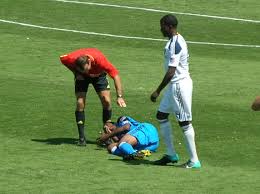
Could this be prevented?
The evidence is quite stark if your child is spending too much time in organised activity rather than free play, if they have specialised in one sport and if they have gone through their growth spurt, then they are more likely to get injured (1).
- 34% of middle school sports participants get injured each year with an estimated medical bill of $2billion (5).
- Talented (or early developing) children get asked to play more sport and therefore have higher injury risk (2).
- The cumulative workload increases injury risk e.g. Cricketers who do more than 75 throws a week (3).
- Early specialisation in one sport leads to an increase in injury risk (4).
- Young athletes participating in more sports hrs/wk than their age and participating in>2 times organized sports:free play are more likely to have a serious overuse injury (1).
- Injury risk increases in teenage girls from 12-13 years old and teenage boys from 14-15 years old: at their growth spurts (6).
Injury Prevention is always better than cure
Why wait until your player is injured? I prefer to have healthy athletes available all year round.
A 2 pronged approach is necessary to greatly reduce the risk of your child or player getting injured.
- Plan your schedule of training and competing. Include free play time.
- Implement a strength/ co-ordination exercise regime and stick to it.
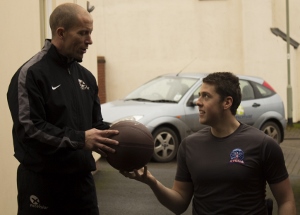 Planning: The best place to start is to look at the next 4 weeks. Use this free 4 weekly planner to help. Put in all the school p.e., games and matches, then club training and matches, plus other activities.
Planning: The best place to start is to look at the next 4 weeks. Use this free 4 weekly planner to help. Put in all the school p.e., games and matches, then club training and matches, plus other activities.
You will probably see a lot of competing and travel, with very few rest days, and little planned physical preparation: running, speed or strength work.
How much free play does your child do? That is “jumpers for goal posts” mucking about with friends in the local park or school playground? None? Then they are at greater risk of injury!
Decisions will have to be made about what is a priority, what is “need to do” rather than “nice to do”. If you are playing more than one age group of a sport, then you should consider dropping the lower one.
Coaches should look at the overall workload that their best players are undergoing: it is unsustainable! Can you afford to lose your best player mid-season?
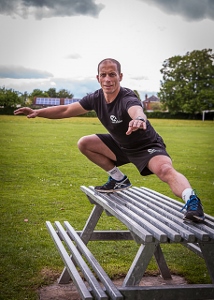 Strength/co-ordination training: It is the ability to control your own body throughout the match and the season that is the key to avoid getting injured. Your exercise programme has to be specific for young athletes: time spent on crosstrainers, exercise bikes and lying down on a bench is time wasted.
Strength/co-ordination training: It is the ability to control your own body throughout the match and the season that is the key to avoid getting injured. Your exercise programme has to be specific for young athletes: time spent on crosstrainers, exercise bikes and lying down on a bench is time wasted.
They need to lunge, squat, brace, rotate, push and pull: in combination with braking, landing, jumping and moving from 2 legs to 1 leg, up, down and side to side.
I get athletes to implement daily routines, at first only 5 minutes, then building up from there. This summer I have designed specific warm up routines for team sports players based on the recent research and my experience.
Members of the Athletic Development Club have all been given my newly designed protocol cards to help them through the season.
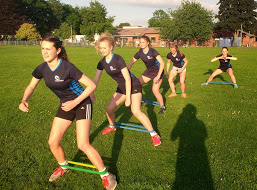
Leg strengthening work
The 11-12 minute warm ups contains all the movements necessary to help reduce the likelihood of injury, as well as improve their sporting performance. If done before every training session and match, the cumulative positive effect will be huge.
Coaches and teachers need to take responsibility
“Quality does not just happen. People who believe so, are people who trust in miracles to make their way through life. Quality excellence is an outcome of preparation and relentless practice. It is surely a given then, that there is time set aside routinely for this.” Frank Dick, Winning Matters.
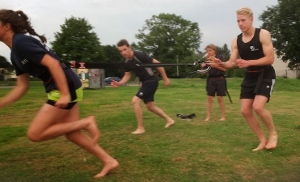
Resisted running drills
I often hear coaches and teachers bemoan the fact that they are struggling to field a team by December due to injuries. Are they still practicing warm up routines that are ineffective and full of time fillers such as jogging, or encourage incorrect mechanics such as high knees and heel flicks?
Do they have a strength programme that helps improve performance and prevent injury? Or do they just use generic exercises that require little co-ordination and involve a lot of sitting or lying down?
A lot of coaches say they are doing the right thing, but how do they know?
Badminton coach James Elkin, Volleyball coach Denise Austin and the Fencing coaches at the SWFencing Hub have shown a great Growth Mindset by looking at what we are doing with their athletes and then changing their practice.
Summary

Technical drills
Injuries are far from things “that just happen“. Chronic pain is abnormal in teenagers, it can be prevented.
Parents, look at how much physical preparation and free play your child is involved in compared to organised camps, travel and competing.
Coaches and teachers either come to one of our strength and conditioning coaching courses or I can run a workshop for your staff that will help all your players and teams.
Let’s work together to help produce healthy, happy and thriving young sportspeople.
This video discussion with Brian McCormick gives more of an overview and guide for parents.
References
- Br J Sports Med 2014 48: 611
- Br J Sports Med 2014;48:1265–1267.
- Br J Sports Med 2011;45:805–8.
- Br J Sports Med 2013;47:503–7.
- The Physician and Sportsmedicine 42(2): p146-153 (2014).
- Acta Orthop. 80(5) p563–567 (2009).
Client Testimonials
I feel that training with South West Talent and James Marshall has been the best thing I've done for my basketball career so far. It has greatly improved my overall athleticism which has been a real benefit to me when on court. More importantly, however, the training has enabled me to continue playing whilst suffering from a back injury which has caused me real problems over a number of years. It has made huge improvements more recently and I am confident that I will be in good shape to play this coming season.
More

